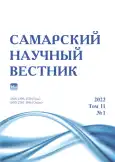The revolutionary movement and the practice of public funerals based on the sources of personal origins
- Authors: Sokolova A.D.1
-
Affiliations:
- N.N. Miklukho-Maklai Institute of Ethnology and Anthropology of the Russian Academy of Sciences
- Issue: Vol 11, No 1 (2022)
- Pages: 255-259
- Section: Historical Sciences
- URL: https://journals.rcsi.science/2309-4370/article/view/108353
- DOI: https://doi.org/10.55355/snv2022111217
- ID: 108353
Cite item
Full Text
Abstract
The paper examines the tradition of politicized public funerals, which was of great importance among those who sympathized with revolutionary ideas in pre-revolutionary Russia, using materials of personal sources. Public funerals of this kind went beyond the boundaries of the traditional confessional funeral rite to a large extent and elicited serious anxiety from the authorities. It is shown that this tradition was born and formed in the second half of the 19th century and allowed the public to express political ideas bypassing the censorship restrictions of that period. The politicized funeral attracted large crowds of participants and spectators, accompanied by revolutionary songs, and ended with speeches and a «civil funeral». The significance of politicized public funerals as a performative practice is shown. It is noted that politicized funerals were not always anti-religious in nature. The reaction of contemporaries to the mass politicized funeral is considered. Memoirists note the extra-state nature of a funeral of this kind, which made it possible to maintain perfect order even without the participation of the police. It is shown that by the time of the 1917 revolution, public revolutionary funerals were already a well-formed social phenomenon, and the ritual of the ceremonial burial of the victims of the revolution on the Field of Mars dates back precisely to this practice.
Full Text
##article.viewOnOriginalSite##About the authors
Anna Dmitrievna Sokolova
N.N. Miklukho-Maklai Institute of Ethnology and Anthropology of the Russian Academy of Sciences
Author for correspondence.
Email: annadsokolova@gmail.com
candidate of historical sciences, researcher of Russian People Department
Russian Federation, MoscowReferences
- Пришвин М.М. Дневники. 1914-1917. 2-е изд., доп. / подг. текста Л.А. Рязановой, Я.З. Гришиной. СПб.: Росток, 2007. 608 с.
- Булгаков С.В. Настольная книга для священно-церковнослужителей: сб. сведений, касающихся преимущественно практической деятельности отечественного духовенства. Киев: Тип. Киево-Печерской Успенской лавры, 1913. 1772 с.
- Sokolova A. When ritual becomes protest: crossing the bridge of Russian mourning // Javnost. 2020. Vol. 27, iss. 1. P. 48-64. doi: 10.1080/13183222.2020.1675424.
- Spontaneous shrines and the public memorialization of death /j. Santino (ed.). N.Y.: Palgrave Macmillan, 2006. 358 p.
- Grassroots memorials. The politics of memorializing traumatic death / ed. by P.J. Margry, C. Sánchez-Carretero. New York-Oxford: Berghahn, 2011. 376 p.
- Полищук Н.С. Обряд как социальное явление (на примере «красных похорон») // Советская этнография. 1991. № 6. С. 25-39.
- Короленко В.Г. Похороны Некрасова и речь Достоевского на его могиле // Ф.М. Достоевский в воспоминаниях современников. В 2 т. Т. 2. М.: Худож. лит., 1990. С. 197-200.
- Никелл У. Смерть Толстого и жанр публичных похорон в России // Новое литературное обозрение. 2000. № 44 (4). С. 43-61.
- Дневник генерал-фельдмаршала графа Дмитрия Алексеевича Милютина. 1876-1878. М.: Росспэн, 2009. 703 с.
- Минцлов С.Р. Петербург в 1903-1910-х гг. Б.м.: Salamandra P.V.V., 2012. 287 с.
- Фидлер Ф.Ф. Из мира литераторов: характеры и суждения. М.: Новое литературное обозрение, 2008. 864 с.
- Теляковский В.А. Дневники директора Императорских театров. 1906-1909. Петербург. М.: Арт, 2011. 928 с.
- Живаго А.В. Дневник А.В. Живаго: театральные заметки (1874-1912). М.: Государственный Центральный театральный музей, 2016. 376 с.
- Прокофьев В.А. Дубровинский. М.: Молодая гвардия, 1969. 224 с.
- Николай Эрнестович Бауман [Электронный ресурс] // Московский государственный технический университет им. Н.Э. Баумана. http://hoster.bmstu.ru/~vil/bauman.htm.
- Найденов А.А. Альбом фотографий 1889-1915. Семейная хроника. Дневник Тани Найденовой 1904-1907. М.: Близнецы, 2001. 395 с.
- Белый А. Петербург: Роман в восьми главах с прологом и эпилогом. Л.: Наука. Ленингр. отделение, 1981. 696 с.
- Белый А. Князь С.Н. Трубецкой // Весы. 1905. № 9-10. С. 79-80.
Supplementary files






